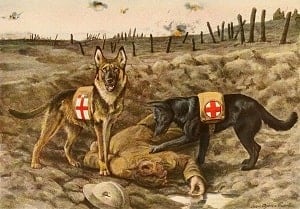Dogs may have been by our side for at least 23,000 years, a new study finds. Science is quickly closing the debate about how long dogs have been our best friends. A February 2021 study published in the Proceedings of the National Academy of Sciences suggests dogs were domesticated in Siberia during the Last Glacial Maximum – the last ice age. As loyal as ever, canines have been taking long walks beside us and keeping us warm for thousands of years.
The arrival of dogs in our lives has been up for debate since it’s difficult for scientists to distinguish ancient wolf remains from ancient dog remains. Some scientists have suggested that dogs were first domesticated about 100,000 years ago, according to a report in The University of Chicago Press Journals, but the common, now outdated, hypothesis is that humans first domesticated wolves, creating the domesticated dog roughly 12,000 years ago.

Photo Courtesy: Pixabay
Other researchers claim the earliest archaeological records state domesticated dogs first appeared about 15,000 years ago in Germany, and other areas across Europe, according to Science Alert. The new hypothesis suggests Siberians learned how to live with wolves when conditions were at their worst, essentially forcing the two to find a way to live in harmony.
“The challenge for all claims of late Pleistocene dogs has been to show conclusively, across several lines of evidence, that the specimen(s) in question can be clearly distinguished from contemporaneous wolves,” researchers from Durham University stated in the new study.
Durham University archaeologist Angela Perri and colleagues compared genome sequences to find a common ancestor for the wolf and dog. Using ancient and modern dogs, researchers created a timeline to figure out when the populations split or interbred, according to Ars Technica. The timeline strongly suggests that when people first came to the Americas, they brought dogs with them.

Photo Courtesy: Pixabay
15,000 to 16,000 years ago, people moved south along the Pacific coast of North America. At the same time, dog packs split from the Arctics and formed a new branch, which created the maternal lineage for all North American dogs.
“There are some dogs that have small amounts of those lineages, such as the Carolina Dog or some Chihuahuas, but most dogs in the Americas today all genetically look like European breeds,” said Kelsey Witt Dillon, co-author and molecular biologist at Brown University, according to Ars Technica.
“Similar to how many Native Americans were killed by Europeans through warfare and disease, their dogs were likely also targeted by European colonizers and died from diseases from European dogs,” Dillon continued. “And when Europeans brought their dogs with them in large numbers, European breeds eventually replaced a lot of the genetic lineages we see in these ancient dogs.”

Photo Courtesy: Pixabay
When and where – or if – dogs were domesticated sparks a lot of interest, but researchers at Durham University also wanted to study how and why dogs became our best friends. With the advancement of science, researchers can now combine efforts. Using archaeology, genetics, and time, researchers can get a better idea of how today’s dogs came to be.
“Climatic conditions may have brought human and wolf populations into close proximity within refugial areas, given their attraction to the same prey species. Increasing interactions between the two, perhaps resulting from the mutual scavenging of kills, or from wolves drawn to the detritus of human campsites, may have initiated a shift in the relationship between the species, eventually leading to dog domestication,” per the study, according to Science Alert.
Regardless of where, when, how, or why canines came to be our best buds, science has proven what many already know – dogs are beneficial to our well-being. Could the Siberians have learned canines offer a healing effect? Perhaps they came to realize living in harmony was not only possible but beneficial for all involved. Science now tells us that dogs promote a sense of calm in humans, and though it’s highly unlikely facing down a wild wolf brought on calmness, Siberians needed to survive, and forming a mutual acceptance might have ushered in some peace.

Photo Courtesy: Pixabay
Forced due to hardship or not, the human-dog relationship has been of interest and studied for decades. Past human-animal interaction studies have linked changes in the neurotransmitters cortisol, epinephrine, and norepinephrine – changes that reduce stress in humans – to our connection to dogs. We now know that petting a dog also releases oxytocin, another hormone and neurotransmitter that helps regulate a wide variety of functions within the body. A research article published in Progress of Neurobiology calls oxytocin “the great facilitator of life.”
Many other studies regarding the dog-human relationship have proven dogs to be great as service animals – dogs that perform a particular task for a specific individual, emotional support animals – dogs whose presence is required for the mental health of an individual, and therapy animals – dogs who are trained to assist people going through a crisis.
Though many of today’s dogs look nothing like their ancestors, they have been loyal and beneficial companions for at least 23,000 years.
Man’s best friend, indeed.
Featured Image Courtesy: Pixabay







